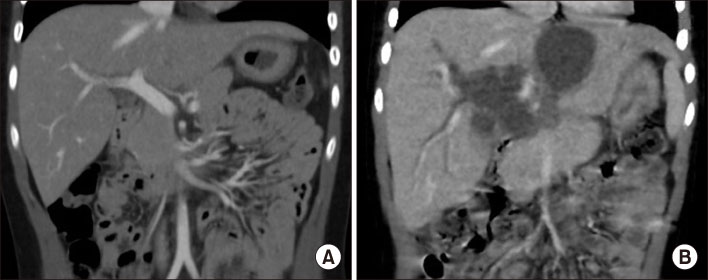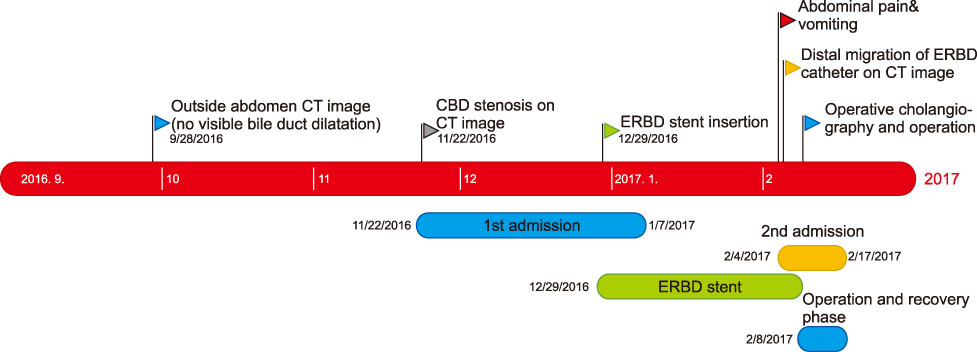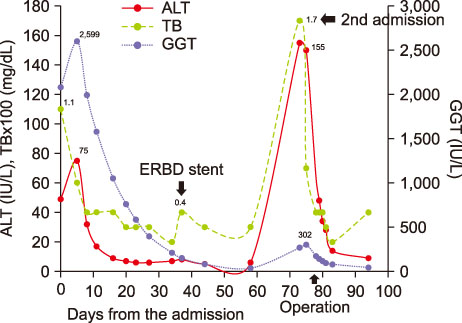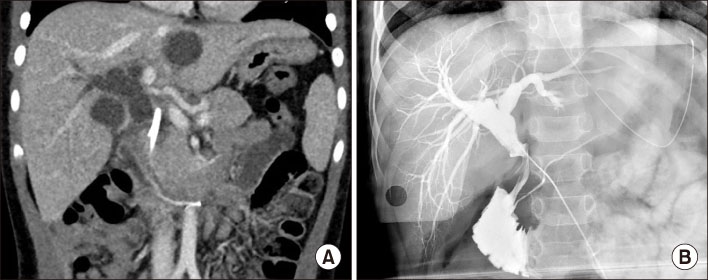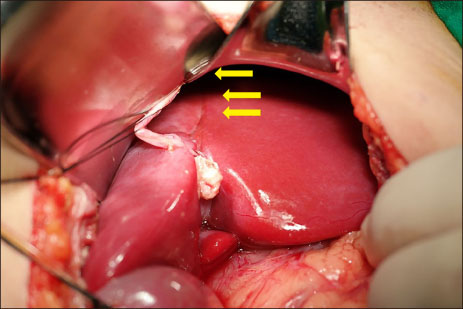J Korean Assoc Pediatr Surg.
2018 Jun;24(1):30-34. 10.13029/jkaps.2018.24.1.30.
Bile Duct Stricture and Intrahepatic Cystic Formation after Abdominal Injury due to Child Abuse: A Case Report
- Affiliations
-
- 1Department of Surgery, Yonsei University College of Medicine, Seoul, Korea. sjhan@yuhs.ac
- 2Department of Pediatric Surgery, Severance Children's Hospital, Seoul, Korea.
- 3Department of Pediatric Surgery, Keimyung University Dongsan Medical Center, Daegu, Korea.
- KMID: 2415884
- DOI: http://doi.org/10.13029/jkaps.2018.24.1.30
Abstract
- A 6-year-old male who lived with a mother in a single-parent family was referred to the emergency room with multiple traumas. There was no specific finding on CT scan of the other hospital performed 55 days before admission. However, CT scan at the time of admission showed common bile duct (CBD) stenosis, proximal biliary dilatation and bile lake formation at the segment II and III. Endoscopic retrograde biliary drainage was performed, but the tube had slipped off spontaneously 36 days later, and follow-up CT scan showed aggravated proximal biliary dilatation above the stricture site. He underwent excision of the CBD including the stricture site, and the bile duct was reconstructed with Roux-en-Y hepaticojejunostomy. Pathologic report of the resected specimen revealed that the evidence of trauma as a cause of bile duct stricture. While non-iatrogenic extrahepatic biliary trauma is uncommon, a level of suspicion is necessary to identify injuries to the extrahepatic bile duct. The role of the physicians who treat the abused children should encompass being suspicious for potential abdominal injury as well as identifying visible injuries.
Keyword
MeSH Terms
Figure
Reference
-
1. National Child Protection Agency. 2015 National Children's Abuse Status Report. Sejong: Ministry of Health and Bureau of childcare policye;2016.2. Ledbetter DJ, Hatch EI Jr, Feldman KW, Fligner CL, Tapper D. Diagnostic and surgical implications of child abuse. Arch Surg. 1988; 123:1101–1105.
Article3. Hudson M, Kaplan R. Clinical response to child abuse. Pediatr Clin North Am. 2006; 53:27–39. v
Article4. Takamizawa S, Nozaki N, Aoyama N, Nishijima E, Muraji T. Endoscopic retrograde biliary drainage for posttraumatic intrapancreatic biliary stenosis in a child. J Pediatr Surg. 2009; 44:e25–e28.
Article5. McDonald KC. Child abuse: approach and management. Am Fam Physician. 2007; 75:221–228.6. Kellogg ND. American Academy of Pediatrics Committee on Child Abuse and Neglect. Evaluation of suspected child physical abuse. Pediatrics. 2007; 119:1232–1241.
Article7. Park DH, Kim MH, Kim TN, Son HY, Lee TY, Kwon S, et al. Endoscopic treatment for suprapancreatic biliary stricture following blunt abdominal trauma. Am J Gastroenterol. 2007; 102:544–549.
Article8. Yoon KH, Ha HK, Kim MH, Seo DW, Kim CG, Bang SW, et al. Biliary stricture caused by blunt abdominal trauma: clinical and radiologic features in five patients. Radiology. 1998; 207:737–741.
Article9. Mullady DK, Carr-Locke DL. Traumatic biliary stricture. Medscape J Med. 2008; 10:114.10. Yu L, Hao J, Wang WL, Xia JM, Lu Y, Wang B. Treatment of late biliary stricture after blunt abdominal trauma. Eur J Gastroenterol Hepatol. 2013; 25:690–693.
Article
- Full Text Links
- Actions
-
Cited
- CITED
-
- Close
- Share
- Similar articles
-
- Type IV-A Choledochal Cyst with Intrahepatic Bile Duct Stricture
- Intrahepatic Bile Duct Dilatation Caused by Pancreatic Pseudocyst: A Case Report
- Actinomycosis of the intrahepatic bile duct concomitant with intrahepatic duct stones
- Solitary intrahepatic bile-duct cyst presenting with jaundice
- Complete Transection of the Cystic Duct and Artery after Blunt Trauma: A Case Report

